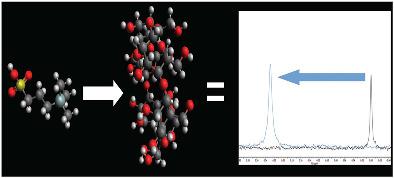当前位置:
X-MOL 学术
›
Magn. Reson. Chem.
›
论文详情
Our official English website, www.x-mol.net, welcomes your feedback! (Note: you will need to create a separate account there.)
NMR internal standard signal shifts due to cyclodextrin inclusion complexes
Magnetic Resonance in Chemistry ( IF 2 ) Pub Date : 2021-05-07 , DOI: 10.1002/mrc.5180 Colleen L Ray 1 , James A Gawenis 2 , Michael Harmata 1 , Charles Michael Greenlief 1
Magnetic Resonance in Chemistry ( IF 2 ) Pub Date : 2021-05-07 , DOI: 10.1002/mrc.5180 Colleen L Ray 1 , James A Gawenis 2 , Michael Harmata 1 , Charles Michael Greenlief 1
Affiliation

|
Nuclear magnetic resonance (NMR)-based screening of materials is a powerful tool for quality control, authenticity testing, and purity testing of compounds. However, reliance on 3-(trimethylsilyl)-propane-1-sulfonate (DSS) and 3-(trimethylsilyl)propanoic acid (TMSP) for referencing the spectra of aqueous samples is not without hazard, particularly with automated analyses. The assumption that these reference signals always represent 0 ppm is ubiquitous in NMR spectroscopy and is routinely used for spectral alignment. However, it has been found that cyclodextrins readily generate inclusion complexes with DSS and TMSP with the effect of rendering this assumption incorrect. These inclusion complexes alter the electronic shielding of the trimethylsilane functional groups on DSS and TMSP yielding a small, but significant, shift to a higher frequency in the signal relied upon for spectral referencing. As a result, samples containing traces of these compounds may be incorrectly declared fraudulent, inconsistent with standards, or adulterated. In order to maintain the viability of this screening method, vigilance and/or improved referencing of spectra is needed.
中文翻译:

由于环糊精包合物引起的 NMR 内标信号偏移
基于核磁共振 (NMR) 的材料筛选是用于化合物质量控制、真实性测试和纯度测试的强大工具。然而,依赖 3-(三甲基甲硅烷基)-丙烷-1-磺酸盐 (DSS) 和 3-(三甲基甲硅烷基)丙酸 (TMSP) 来参考水性样品的光谱并非没有危险,尤其是在自动分析中。这些参考信号始终代表 0 ppm 的假设在 NMR 光谱中无处不在,并且通常用于光谱对齐。然而,已经发现环糊精很容易与 DSS 和 TMSP 生成包合物,从而使这种假设不正确。这些包合物改变了 DSS 和 TMSP 上三甲基硅烷官能团的电子屏蔽,产生了一个很小但很重要的,移至频谱参考所依赖的信号中的更高频率。因此,含有痕量这些化合物的样品可能会被错误地宣布为欺诈、不符合标准或掺假。为了保持这种筛选方法的可行性,需要提高警惕和/或改进光谱参考。
更新日期:2021-05-07
中文翻译:

由于环糊精包合物引起的 NMR 内标信号偏移
基于核磁共振 (NMR) 的材料筛选是用于化合物质量控制、真实性测试和纯度测试的强大工具。然而,依赖 3-(三甲基甲硅烷基)-丙烷-1-磺酸盐 (DSS) 和 3-(三甲基甲硅烷基)丙酸 (TMSP) 来参考水性样品的光谱并非没有危险,尤其是在自动分析中。这些参考信号始终代表 0 ppm 的假设在 NMR 光谱中无处不在,并且通常用于光谱对齐。然而,已经发现环糊精很容易与 DSS 和 TMSP 生成包合物,从而使这种假设不正确。这些包合物改变了 DSS 和 TMSP 上三甲基硅烷官能团的电子屏蔽,产生了一个很小但很重要的,移至频谱参考所依赖的信号中的更高频率。因此,含有痕量这些化合物的样品可能会被错误地宣布为欺诈、不符合标准或掺假。为了保持这种筛选方法的可行性,需要提高警惕和/或改进光谱参考。



























 京公网安备 11010802027423号
京公网安备 11010802027423号